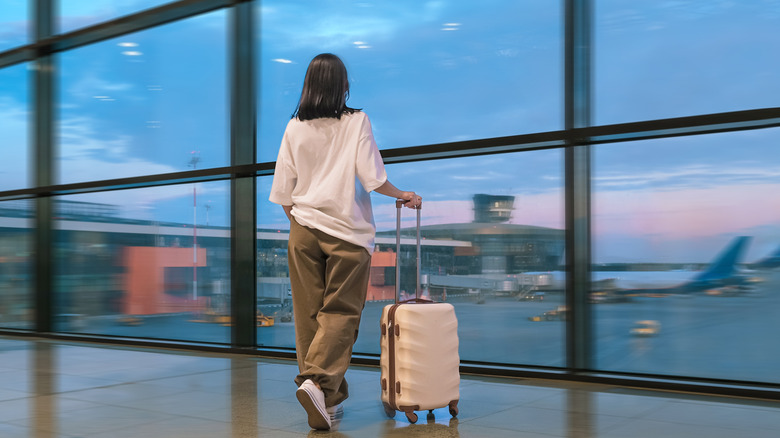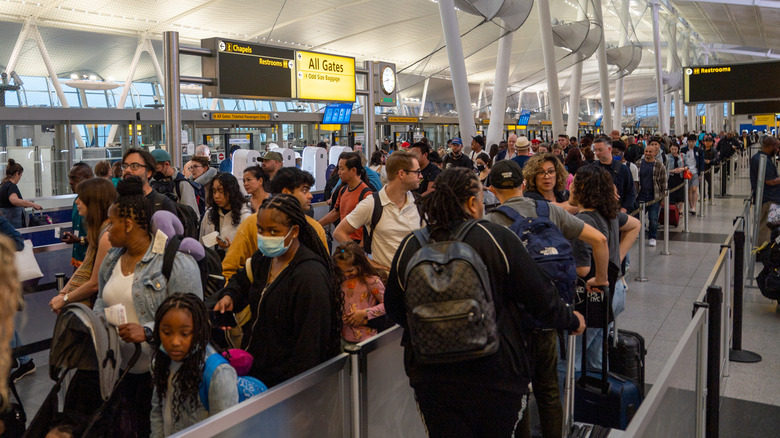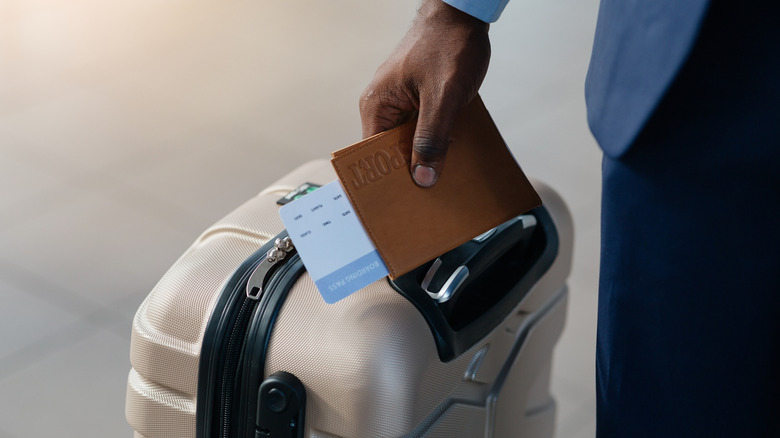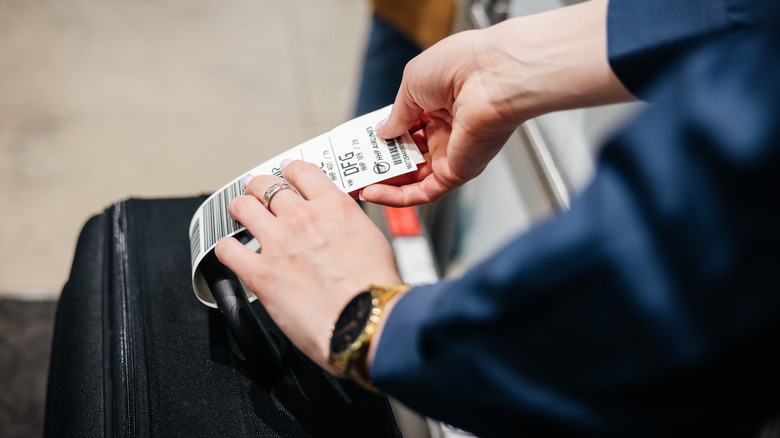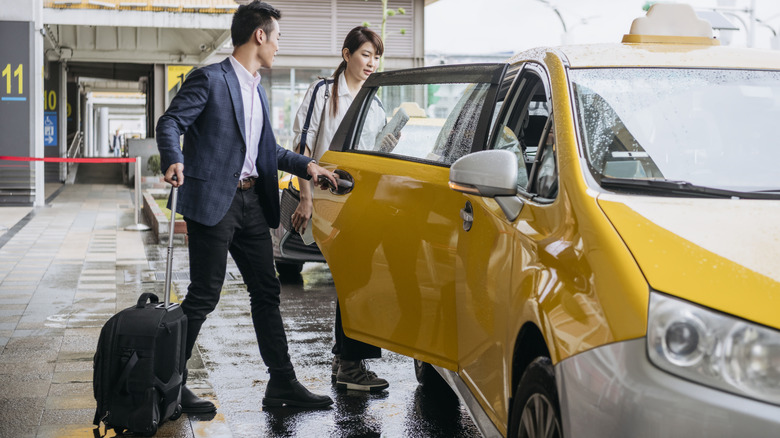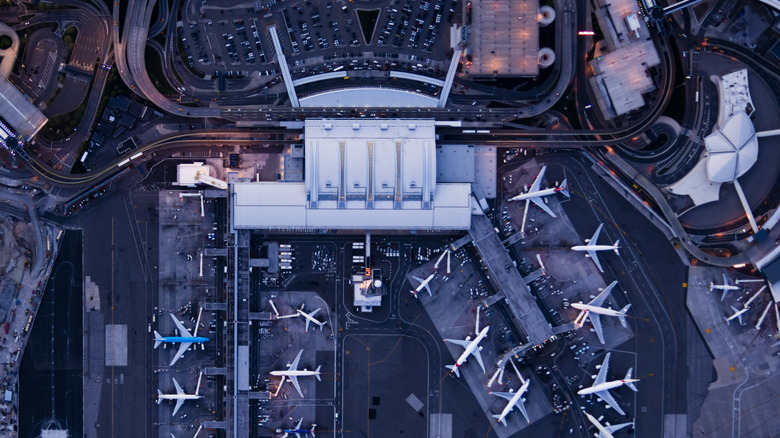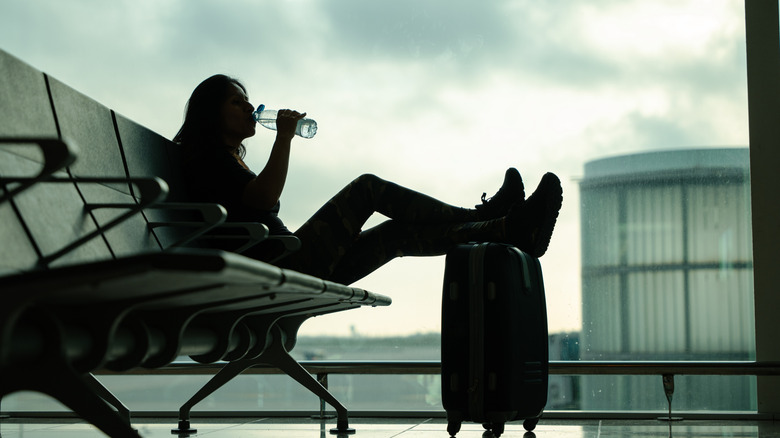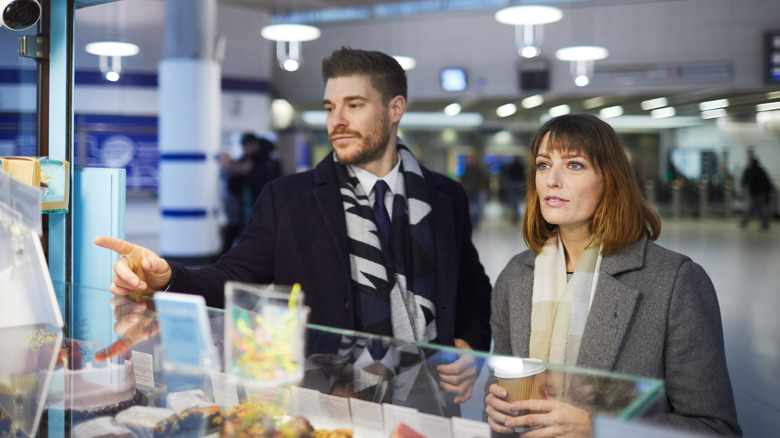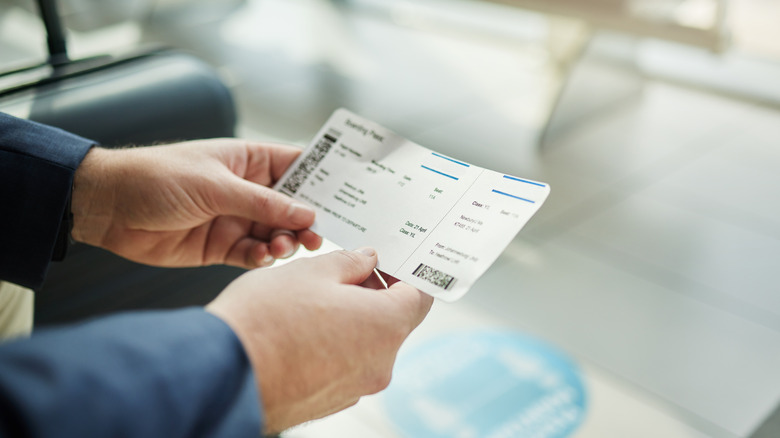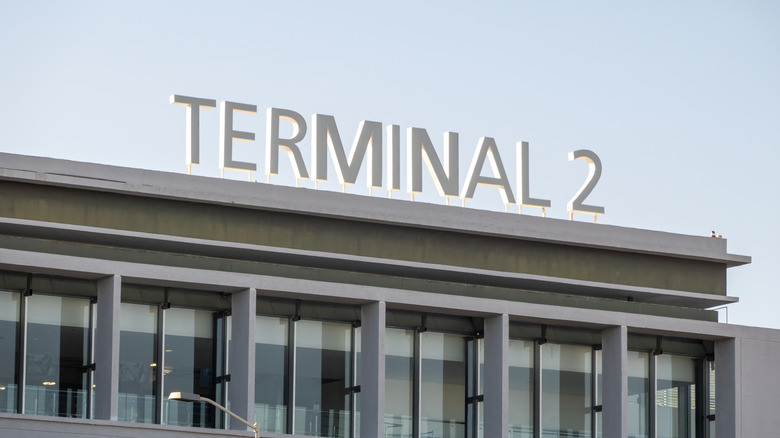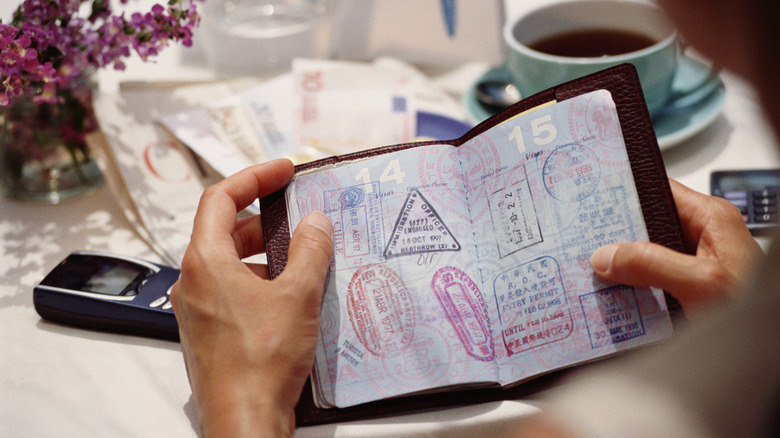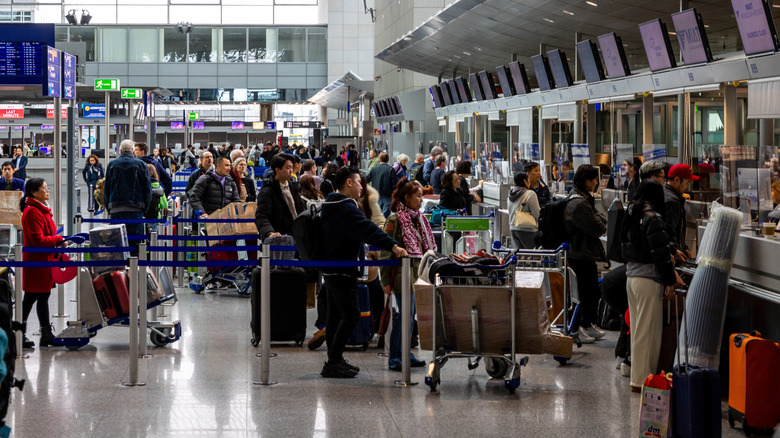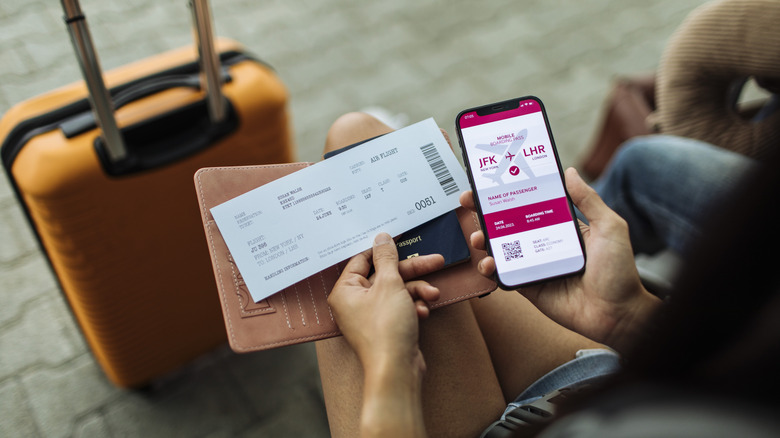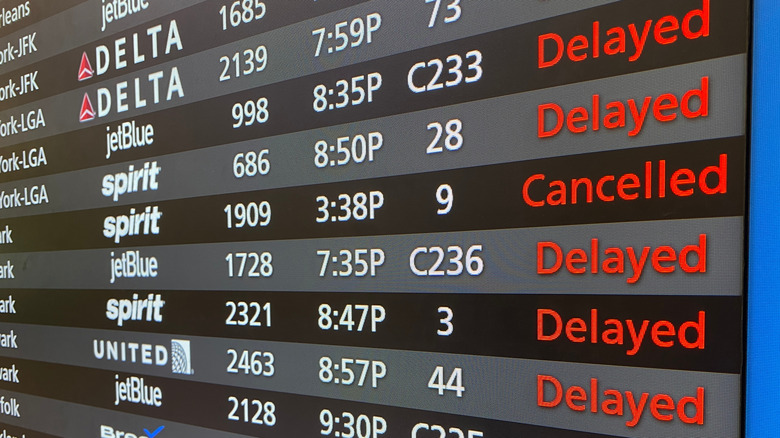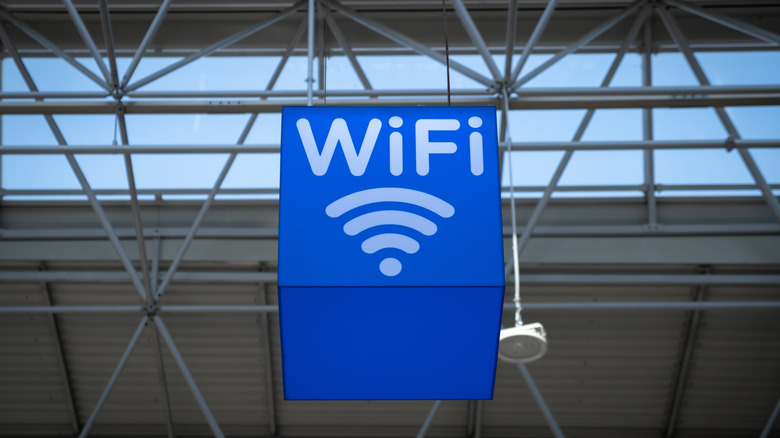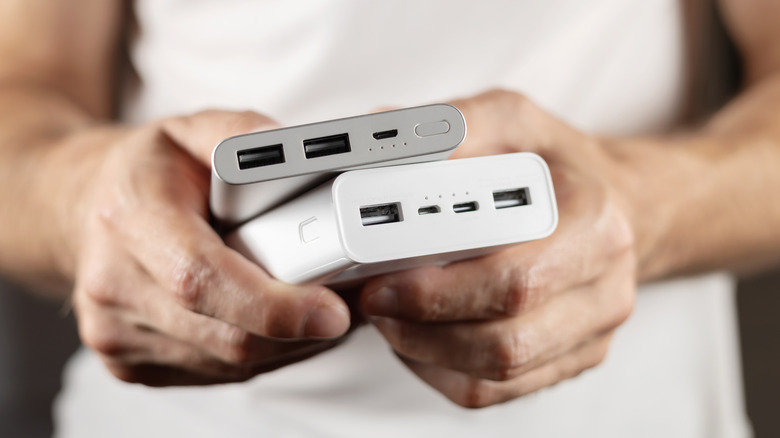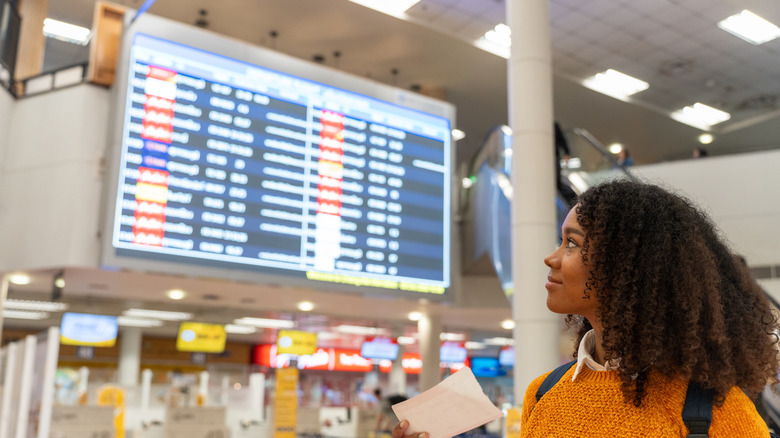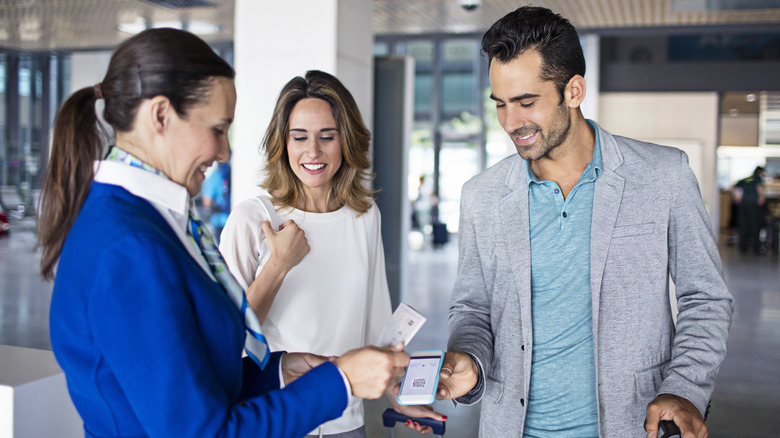Don't Make These Common Mistakes When You Go To The Airport For The First Time
A traveler's first time at the airport is filled with excitement. You're only a few hours away from embarking on a trip and there are lots of reasons to feel giddy, but don't let that eagerness make you irresponsible. Before you officially get on the plane and prepare for take-off, there are still quite a few things to do and think about at the airport.
Getting through the airport is one of the most crucial parts of the travel process for the 4.5 billion people who take flights per year. Making an error along the way can be the difference between you making your flight or being left behind stranded. Are you preparing for your very first flight experience and getting nervous about making a misstep while you're at the airport?
Don't worry. You're in the right place. We're going to break down all of the most common mistakes that people make at the airport and exactly how you can avoid them during your big travel day.
Failing to arrive at least two hours prior to take-off
One of the cardinal rules of the airport that even novice travelers are familiar with is arriving at the airport early. Yet, failing to get there early enough is still one of the most common blunders that people make before a trip. Many people wonder how early they really need to arrive at the airport, even if they have TSA Pre-Check.
The answer is a bare minimum of two hours before your flight departs. If you're flying overseas, you should arrive about three hours before take-off since there could be additional steps to get through. While this sounds like an exorbitant amount of time, it really is the exact amount you need to do airport activities like checking your bag and getting through the security line.
At major U.S. airports, it's very common for the security line to take up to an hour or more on busy days. If you get caught in a lengthy security line and you've only given yourself an hour or less to get through the airport, there is a very high chance that you could miss your flight altogether. When it comes to air travel, it is always better to have extra time on your hands than to rush through the crowds in a desperate attempt to reach your gate before it's too late.
Packing restricted items in your checked bag or carry-on
One of the things that can hinder you from making your flight on time is your baggage. Specifically, the items you pack inside of it. There are a bunch of things that you absolutely cannot bring in your carry-on or checked bag during a flight. If you've packed these objects in your bags, it could cause a big delay in your travel plans.
Aerosol cans, technology containing lithium-ion batteries like laptops, smartphones, and portable chargers, firearms, fireworks, paint, and anything over 70% alcohol are not allowed to be stowed in your checked bag. These items are banned because they can be dangerous in the middle of a flight. There are regulations surrounding what's allowed in your carry-on bag as well. A few examples of things that are banned from your carry-on include knives, scissors, corkscrews, liquids over 100 milliliters, syrups, baseball bats, hiking sticks, and hammers.
Ignoring the airline's baggage policies
Each airline has its own baggage allowances and it's important to pay attention to these restrictions. If you go over the airline's weight and size allowances, you could end up paying an exorbitant fee. The best way to avoid the never-ending airline baggage fees right before your flight is to familiarize yourself with your air carrier's baggage limits.
The majority of airlines permit you to check bags that weigh up to 23 kilograms or a little over 50 pounds. The bag also needs to be less than 90x75x43 centimeters on average. The weight and size allowances are usually more limited for budget airlines, so it's smart to double-check with your air carrier.
In addition to your checked bag, most major airlines let passengers bring one carry-on bag with them on the plane. Typically, the carry-on bag must be small enough to fit in the overhead compartments on the plane and weigh less than 7 kilograms or a tad over 15 pounds. If your bag goes over this size, you may be asked to check the bag for an extra fee or check your bag in at the gate.
Setting up their transportation to the airport last minute
Before you can check your bag or find your gate, you must actually get to the airport first. It seems like a simple concept, but it can be a bigger headache than you might anticipate as a first-time flyer. Driving to the airport requires leaving your vehicle in their extremely overpriced parking lots. On the other hand, taking a ride share to the airport can be risky depending on the time of your flight because you could be left waiting helplessly for your app to find a driver. This greatly increases the chances that you'll end up running late.
The smartest way to handle this is to schedule your ride share in advance to ensure you'll arrive at your terminal with plenty of time to spare. With Uber, users can schedule a ride as little as 30 minutes before their trip or as much as 30 days in advance. For a trip to the airport, it's recommended to schedule your ride at least a day or two before your departure.
Not reviewing the airport's layout
Newbie travelers often underestimate how large an airport can be. It is possible that you could need to walk up to two miles to reach your gate at certain U.S. airports and that takes a massive amount of time — especially when you're trying to make your way through thousands of other travelers. In an airport that is so spacious, it also increases the chances of getting lost along the way.
That's why it is critical to review your airport's layout before your travel day. This is even more important when you're flying out of Denver International, Dallas/Fort Worth International, Orlando International, or Washington Dulles International because they are each one of the top five largest airports on the planet. The airport's website or app will typically provide a full map of its layout or you can simply search Google Images for it. Once you find the map, make sure you take a screenshot, so you'll have access to it even if there isn't any service at the airport.
Forgetting to drink enough water throughout the travel day
In the chaos of trying to get on a flight, many people make the hazardous mistake of forgetting to drink enough water and eat enough food. This is a major problem before getting on a plane because the chances of dehydration are so much greater. On average, planes tend to keep the humidity between 10 percent and 20 percent, but the human body is acclimated to a humidity of 30 percent to 60 percent on the ground.
This exceedingly dry environment makes people get dehydrated way faster in the air if they're not staying on top of their water intake. Due to these extreme conditions, the Aerospace Medical Association advises travelers to drink one cup of water for every hour they're flying. It's a good idea to bring a reusable water bottle because airport security will force you to get rid of disposable ones.
You should be just as diligent about eating food during your travel day. While you shouldn't indulge in too many intense flavors or try unfamiliar cuisine, a little snack before a flight will help you feel your best throughout the journey. Otherwise, there's a high chance of getting airsick on the plane.
Miscalculating costs of food inside the airport
The prices of food and drinks at an airport can be a big shock for someone who has never flown before. In this self-contained setting, the reality is that airport vendors can charge way more for their products and they raise the costs all the time. In 2024 two popular airport retailers, Pret A Manger and WH Smith inflated their rates by almost 50 percent, according to The Independent.
As a rule of thumb, you should estimate that airport food prices will be up to 15% higher than anything you'd find in the outside world. If those kinds of prices aren't feasible for your trip's budget, you can always bring your own snacks to munch on. While travelers aren't allowed to bring more than 100 milliliters of liquid through security, they are permitted to have most foods. The TSA website has the most up-to-date list of the food items that are allowed through security and on the plane.
Not examining their flight details carefully enough
Familiarizing yourself with your flight details is a key part of having a smooth airport experience. It sounds like a simple thing, but it can trip a lot of people up if they're not paying enough attention. There will be important information on both the flight itinerary you receive right after booking and the boarding pass you're given after checking in.
The flight itinerary that's sent to your email will include things like your departure and arrival times and your flight number. These details help you organize your arrival plans once you get to your destination and allow your loved ones to keep tabs on your flight. Your boarding pass will tell you everything you need to know when you're physically at the airport, such as your boarding time, your gate, your boarding group or number, and your seat. All of which you need to keep in mind until the moment you sit down on the plane.
Getting dropped off at the wrong terminal
It's imperative that you get dropped off at the correct terminal for your flight or you could end up on an unintended hike on the day of your vacation departure. Many of the major airports around the world have terminals that can be more than a mile away from each other. That can spell disaster if you're already late for your flight.
For instance, Philadelphia International Airport's Terminal A is located over a mile away from Terminal E. At Hartsfield-Jackson Atlanta International Airport, the distance between its international and domestic terminals is double that length at over two miles apart! Walking an extra mile or two during a hectic travel day can really slow things down. At best, you'll show up to check-in for your flight out of breath and already stressed out and at worst you could even miss your flight completely.
Not holding on to all the necessary travel documents and identification
Throughout your whole journey around the airport, you should know exactly where your travel documents and identification are at all times. At the bare minimum, this will include your boarding pass and passport for international flights or your state ID for domestic ones. However, depending on your trip it could also include items like visa paperwork or other required documents.
You'll want to keep all this stuff on your person, particularly if you're taking an international flight. Even your carry-on can be a bad place to put your passport at the airport because it's easy for it to slip your mind if you decide to check your bag at the gate and that can create massive issues at customs. Investing in a passport holder that goes around your neck or waist is a good idea to keep everything organized and within reach at the airport.
Standing in the wrong lines at check-in and security
Long lines are a given at busy airports and many passengers get confused about where they're supposed to be. Usually, getting in the wrong line might give you a chuckle, but it will be nowhere near as humorous when you're trying to get through the droves of travelers to make a flight. The airport is definitely one of those places where you should readily ask questions to make sure you're in the right line.
This is really crucial when you're going through security because it can take well over an hour to get through and not every line is for regular passengers. There are various programs like TSA PreCheck, Clear, and Global Entry that have their own pedestrian flow at airport security. If you stand in one of these lines as a normal passenger, it can waste a ridiculous amount of time when they send you back to the end of the general security line.
Not checking in for your flight online in advance
You want your airport experience to be as efficient as possible. One simple method for making the entire day much more straightforward is checking in for your flight online. Online check-in is usually made available for most travelers sometime between 24 and 48 hours before take-off. Pretty much every major airline gives their passengers this option these days and it makes everything much less stressful.
All you have to do is answer a few basic questions and do things like choose your seat, request any upgrades, and pick your meal options. Then, you'll be presented with your mobile boarding pass. At the airport, all you have to do is drop off your checked bags and make your way through security. Not only does checking in online save you a bunch of time on your travel day, but it also prevents you from being a victim of airline overbooking.
Skipping out on travel insurance
People who are new to traveling often wonder if they need travel insurance. After all, it is an extra expense when taking a flight is already so expensive. While it costs a little bit more, having travel insurance can actually save you a lot of money in the long run if anything goes wrong. While each provider differs slightly, this type of insurance generally covers expenses that arise from unforeseen travel issues or medical problems.
Imagine you end up missing your connecting flight because of a delay and then being stuck footing the bill for a hotel, new flight, car rental, or whatever else you need to fix the problem. What if you have an accident while you're traveling and need to pay pricey medical bills? Your checked luggage could get lost or your return flight could get cancelled. Travel insurance protects you in situations like these and more.
Using airport Wi-Fi without the protection of a VPN
It's completely normal to absent-mindedly connect your devices to free public Wi-Fi. Making this one seemingly small decision at an airport can actually be quite risky, though. Hackers apparently love airports because they have really loose security compared to other public spaces.
One man flying domestically across Australia ended up getting arrested because he was creating fake networks in the hopes that naive travelers would connect to the Wi-Fi. Once they were on it, he would steal their email and social media account information. The best way to protect your information from sketchy airport Wi-Fi is by enabling a VPN on your devices. A virtual private network, or VPN, is designed to conceal your IP address and encrypt your data to hide you from any predators that may be lurking on public Wi-Fi.
Forgetting to bring a portable charger in your carry-on
Anyone who has ever spent time in an airport can tell you that it is insanely difficult to find a functional power outlet. It is such a common occurrence that one Reddit user even asked "Why do so few electrical outlets in airports work?" Another person responded to the post explaining, "At home, this is usually no big deal as you simply do not do it that often on any given plug and, if it wears out, you notice and buy a new one for a few dollars and replace it. In an airport though, there are dozens or more using a given outlet every day. Multiply that by a year of people and that outlet wears down fast."
Even if an airport is stocked up with functional outlets, they are usually all taken up by the thousands of other travelers at the airport each day. Luckily, being prepared with a portable charger at the airport can solve this problem. A power bank with 20,000 milliampere-hours can charge your phone up fully up to six times, which is more than enough to keep it on throughout your entire travel day.
Failing to keep an eye on potential gate changes
Even though you're assigned a gate number on your boarding pass, that isn't set in stone. There is always a possibility that your gate could change at a moment's notice. Gates can be shifted for a variety of reasons from flight delays to mechanical errors. The problem is that some airports may not make an announcement when this happens.
All they'll do is put the gate change up on the flight board and every passenger is responsible for figuring it out on their own. Travelers who aren't paying close enough attention to the board could realize at the last moment that their gate has moved to the opposite end of the terminal. Even once you're past security and settled, stay alert at the airport in case any gate changes occur randomly.
Confusing boarding time and take-off time
A plane's departure time doesn't mean that passengers have until the last minute to get on board. In fact, the gate will typically close about 30 minutes before the departure time and the airline's staff will not let anyone else on board after that point for any reason. What you really need to schedule your day around is your boarding time.
Confusing your boarding and departure time can make you miss your flight even if you've done everything else right over the course of your travel day. On average, boarding time occurs about 45 minutes before take-off. All passengers should be at their gate before boarding begins so that they're within ear-shot if there are any major announcements or the flight attendants start calling their group.
